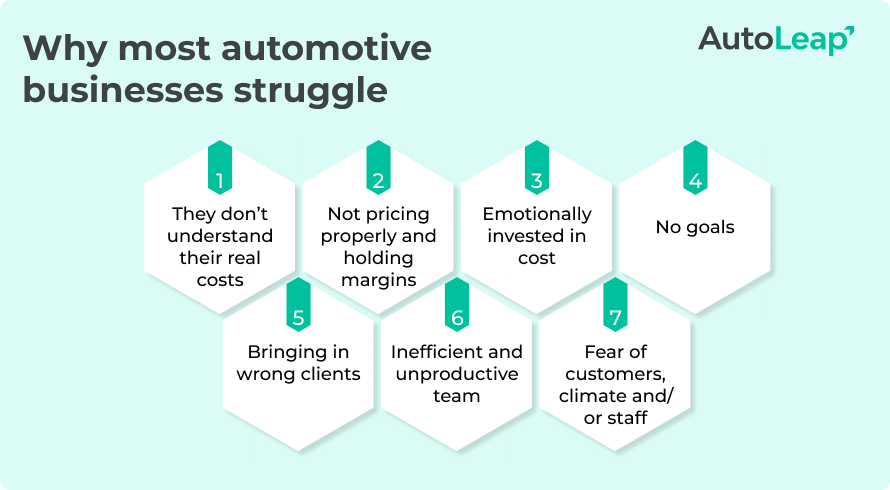What are the keys to becoming a successful shop?
Bullard covered:
- Common automotive business struggles
- Understanding your shop’s financial model
- Setting goals for production, sales & ARO
- Determining your preferred customer profile
- And much more
Let’s recap some of the highlights!
Why most automotive businesses struggle
There are many reasons that auto repair shops struggle. Some relate to finances and processes, while others relate to customer types and team issues.
Specifically, here are some reasons your shop may continue to fall short:

So how can you turn a negative outlook around? Setting goals is a great place to start! “Goals give you a focus, a win and a finish line for the day, week, month and year,” says Cecil.
Understanding your shop’s financial model
How does your shop make money?
For one, you sell parts. Take this example. You place a parts order from your go-to NAPA or Carquest catalog. You then markup the parts and sell them to your customers as part of your shop’s repair services. That’s how you profit.
You also sell labor. To start, you buy that labor from the technician, who you pay per hour. That salary figure is “loaded” to include FICA, worker’s comp, and all other relevant costs. You mark that cost up and sell it to your customers for profit.
Simple concepts, right? But many shops still don’t fully understand their labor costs and how productivity factors in! If an hourly or salary tech isn’t giving you eight hours to bill every day, that cost of labor will rise for your shop.
“Your shop is a machine. If you understand it as a financial model, price yourself correctly and build value for your clients and deliver great service, then you’re going to be very successful,” says Cecil.
You need a plan for calculating your shop’s variable and fixed costs & expenses. This information will also help you determine your net profit.
Cecil walks through a proven process for understanding your shop’s financial model. For context, he provides two examples from a respective balanced and unbalanced business.
Setting shop goals: production, sales & ARO
Once you understand your financial model, it’s time to set your shop’s sales goals.
Cecil explains how to understand what your shop’s hour is worth and establish definitive sales goals.
“You can’t manage people without goals,” adds Cecil.
Determine who you want to work for
Who do you want to work for?
It’s a simple question that many shops don’t know how to answer. To help narrow down your customer type, Cecil shares two models.
He labels the first model as “kiss a lot of frogs”. As the name suggests, it’s one you want to avoid!
This model describes the customers who visit your shop solely for the amazing special you have running. They don’t care about the quality of service at all. The shop they visit next will depend on cheap pricing and great deals.
On the other side, we have the “bring in the right customer” model. It targets the customer who seeks out a great shop experience and is willing to pay for quality. Shops that adhere to this quality standard will have higher AROs, become more profitable, and stay busy with loyal clients.
An increase in pricing is the way to attract this latter model. Customers only seeking deals will stop seeking your services when the discounts dry up. Focus on quality customers who appreciate quality service.
From there, Cecil recommends building your brand around and marketing to this preferred customer type. But remember, you still have to deliver exceptional repairs and service!
A nasty bathroom, poor counter service, or greasy fingerprints on a car door are the small details that can negatively impact customer loyalty in a big way.
Create efficient processes

Efficiency is everything when it comes to your shop management. Cecil says you need to focus on building efficient processes for your:
- Phone sales
- Initial pricing
- Scheduling
- Dispatch
- Tech estimating
- SA estimating
- Sales
“Anything that is keeping our technicians from being productive, management needs to focus on that and build that up and make that run efficiently,” adds Cecil.
Closing thoughts
Running a successful shop (and enjoying the experience) is possible. Leverage these webinar insights to address your struggles, understand financial models, set strategic goals, and identify your ideal customer type.







